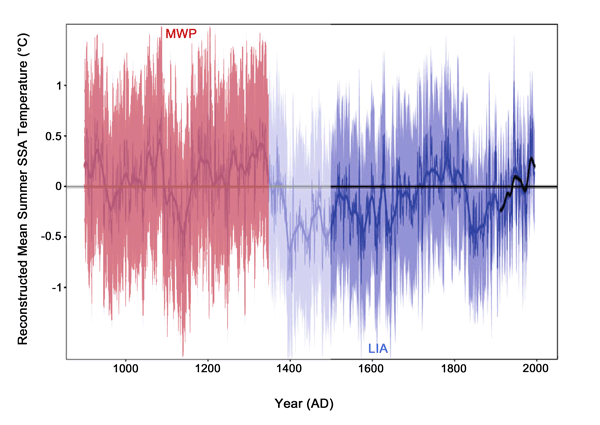Reference
Neukom, R., Luterbacher, J., Villalba, R., Kuttel, M., Frank, D., Jones, P.D., Grosjean, M., Wanner, H., Aravena, J.-C., Black, D.E., Christie, D.A., D'Arrigo, R., Lara, A., Morales, M., Soliz-Gamboa, C., Srur, A., Urritia, R. and von Gunten, L. 2011. Multiproxy summer and winter surface air temperature field reconstructions for southern South America covering the past centuries. Climate Dynamics 37: 35-51.
Background
In order to know how unusual, unprecedented or unnatural the global warming of the 20th century was, it is necessary to do what the eighteen authors of this important paper did, so as to be able, as they describe it, "to put the recent warming into a larger temporal and spatial context."
What was done
Working with 22 of the best climate proxies they could find that stretched far enough back in time, Neukom et al. reconstructed a mean austral summer (December-February) temperature history for the period AD 900-1995 for the terrestrial area of the planet located between 20°S and 55°S and between 30°W and 80°W -- a region they call Southern South America (SSA) -- noting that their results "represent the first seasonal sub-continental-scale climate field reconstructions of the Southern Hemisphere going so far back in time."
What was learned
The international research team -- composed of scientists from Argentina, Chile, Germany, Switzerland, The Netherlands, the United Kingdom and the United States -- write that their summer temperature reconstruction suggests that "a warm period extended in SSA from 900 (or even earlier) to the mid-fourteenth century," which they describe as being temporally located "towards the end of the Medieval Climate Anomaly as concluded from Northern Hemisphere temperature reconstructions." And as can be seen from the figure below, the warmest decade of this Medieval Warm Period was calculated by them to be AD 1079-1088, which as best we can determine from their graph is about 0.17°C warmer than the peak warmth of the Current Warm Period.

Figure 1. Reconstructed mean summer SSA temperatures. Adapted from Neukom et al. (2011).
What it means
The findings of Neukom et al. go a long ways towards demonstrating that: (1) the Medieval Warm Period was a global phenomenon that was comprised of even warmer intervals than the warmest portion of the Current Warm Period, and that (2) the greater warmth of the Medieval Warm Period occurred when there was far less CO2 in the air than there is nowadays, which facts clearly demonstrate that the planet's current -- but not unprecedented -- degree of warmth need not be CO2-induced.




